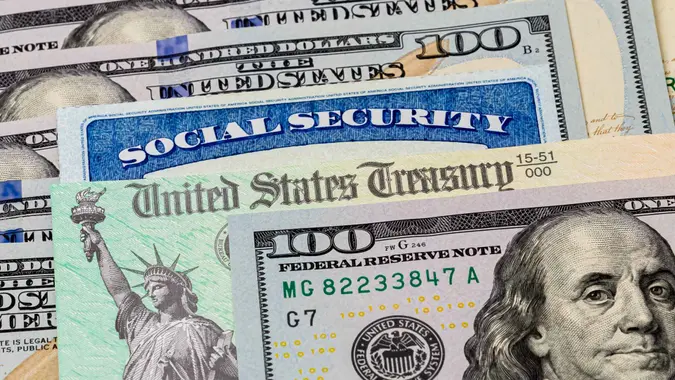Social Security: How Inflation Impacts Paycheck Withholding

Commitment to Our Readers
GOBankingRates' editorial team is committed to bringing you unbiased reviews and information. We use data-driven methodologies to evaluate financial products and services - our reviews and ratings are not influenced by advertisers. You can read more about our editorial guidelines and our products and services review methodology.

20 Years
Helping You Live Richer

Reviewed
by Experts

Trusted by
Millions of Readers
If you wonder how inflation affects the amount of Social Security taxes withheld from your paycheck, you can start by knowing this: Your tax obligation pretty much always goes up, regardless of the broader inflationary environment.
In 2022, 6.2% of your wages are withheld from your paycheck for Social Security taxes if you are an employee who earns $147,000 or less. The total Social Security tax is 12.4%, but your employer takes care of the other 6.2%. If you are self-employed, you’re on the hook for the full 12.4%.
That 6.2% figure has been in place since 1990. It remains the highest percentage ever for Social Security withholding, otherwise known as Old-Age, Survivors, and Disability Insurance.
The first OASDI, implemented in 1937, was 1.0%, according to the Social Security Administration website. In 1950 the OASDI was raised to 1.5%. It then rose to 3.0% by 1960, 4.20% by 1970, 5.08% by 1980 and 6.2% by 1990.
Those hikes were partly the result of inflation — as the prices of goods and services went up, so did the cost of running the Social Security program, and so did wages and withholding rates.
The income ceiling on Social Security withholding has similarly gone higher through the years. For 2022, the ceiling is $147,000, meaning you are taxed on Social Security wages at the full amount for earnings up to $147,000 a year. That figure is up from $142,800 in 2021.
The OASDI income ceiling has risen every year since 2016, when it was $118,500, according to the SSA. In only three of the past 50 years has the ceiling not risen, and in those three years it remained the same. As recently as 2007, the ceiling was less than $100,000.
Again, inflation has a lot to do with the steadily rising income ceiling — both in terms of the prices of goods and services as well as the cost of running Social Security.
You can expect more of the same moving forward. The ceiling for 2023 will be $155,100, MarketWatch reported, citing the recently announced SSA projections for 2023-2030. Here’s how the ceiling will change over the rest of the decade:
- 2024: $165,300
- 2025: $173,400
- 2026: $180,600
- 2027: $188,100
- 2028: $195,600
- 2029: $203,100
- 2030: $210,600
The bottom line is, your income tax withholding for Social Security will continue to move higher through the years, even as Social Security benefits might have to be scaled back to keep the program afloat.
More From GOBankingRates
- Nearly 1 in 3 Americans Hit by a Costly Holiday Scam, Norton Survey Shows -- How To Avoid This
- Here's What Retirees Wasted the Most Money On in 2025 -- and How To Avoid It in 2026
- How Middle-Class Earners Are Quietly Becoming Millionaires -- and How You Can, Too
- 6 Safe Accounts Proven to Grow Your Money Up to 13x Faster
 Written by
Written by  Edited by
Edited by 

























